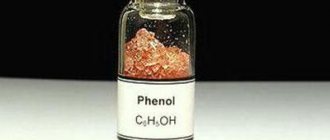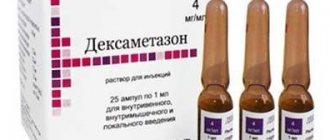| Formaldehyde | |
| Are common | |
| Abbreviations | formaldehyde |
| Traditional names | formicaldehyde, methanal |
| Chem. formula | CH2O |
| Rat. formula | HCHO |
| Physical properties | |
| State | pungent odor gas |
| Molar mass | 30.03 g/mol |
| Density | 0.8153 g/cm³ (-20 °C) |
| Ionization energy | 10.88 ± 0.01 eV[1] |
| Thermal properties | |
| T. float. | -118 °C |
| T. kip. | −19 °C |
| Etc. explosion | 7 ± 1 vol.%[1] |
| Enthalpy of formation | −115.9 kJ/mol |
| Steam pressure | 1 ± 1 atm[1] |
| Classification | |
| Reg. CAS number | 50-00-0 |
| PubChem | 712 |
| Reg. EINECS number | 200-001-8 |
| SMILES | C=O |
| InChI | 1S/CH2O/c1-2/h1H2 WSFSSNUMVMOOMR-UHFFFAOYSA-N |
| Codex Alimentarius | E240 |
| RTECS | LP8925000 |
| ChEBI | 16842 |
| UN number | 2209 |
| ChemSpider | 692 |
| Safety | |
| LD50 | 100 mg/kg (rats, oral) |
| Toxicity | highly toxic, carcinogenic, irritant, contaminant, affects the optic nerve |
| NFPA 704 | 4 3 0 COR |
| Data given is based on standard conditions (25 °C, 100 kPa) unless otherwise stated. | |
Formaldehyde
(from Latin formīca “ant”) is an organic compound, a colorless gas with a pungent odor, highly soluble in water, alcohols and polar solvents. Irritant, contaminant, carcinogen, toxic.
Formaldehyde is the first member of the homologous series of aliphatic aldehydes, the aldehyde of methanol and formic acid.
What is formaldehyde and what is it used for?
Formaldehyde (synonyms: methanal, formic aldehyde, methyl aldehyde; chemical formula CH2O) under normal conditions is a colorless gas with a pungent odor, highly soluble in water.
This substance is produced on an industrial scale by oxidizing methanol. In the article, we will discuss in more detail the sources of formaldehyde release, how long it takes for it to disappear, the norms of H2CO content in the air, the effect of formaldehyde on the body, and the symptoms of carcinogen poisoning. The bactericidal properties of this chemical compound have been known for quite some time - the familiar formaldehyde, used in anatomy for the preservation of tissues and organs, is a common 40% aqueous solution of formicaldehyde.
Tanning properties have made it an indispensable component of products for the leather and woodworking industries. In addition, it is used in the production of various cosmetics, as well as in the food industry (as an additive under code E240).
Receipt
The main industrial method for producing formaldehyde is the oxidation of methanol:
2 CH 3 OH + O 2 → 2 HCHO + 2 H 2 O {\displaystyle {\mathsf {2CH_{3}OH+O_{2}\rightarrow 2HCHO+2H_{2}O}}}
The oxidation of methanol to formaldehyde is carried out using a silver catalyst at a temperature of 650 °C and atmospheric pressure. This is a well-developed technological process, and 80% of formaldehyde is obtained using this method. Recently, a more promising method based on the use of iron-molybdenum catalysts has been developed. In this case, the reaction is carried out at 300 °C. In both processes the conversion rate is 99%[3].
The process of methanol dehydrogenation, carried out on zinc-copper catalysts at 600 °C, has not yet been widely developed, but it is very promising because it allows one to obtain water-free formaldehyde.
There is also an industrial method for producing formaldehyde by oxidizing methane:
CH 4 + O 2 → HCHO + H 2 O {\displaystyle {\mathsf {CH_{4}+O_{2}\rightarrow HCHO+H_{2}O}}}
The process is carried out at a temperature of 450 °C and a pressure of 1-2 MPa; aluminum phosphate AlPO4 is used as a catalyst.
What are the main sources of formaldehyde emissions in an apartment?
Firstly, free formaldehyde is part of the combustion products of organic substances:
- smog, car exhaust
- tobacco smoke and even smoke from electronic cigarettes
- evaporation from the fireplace and gas stove
Secondly, formaldehyde evaporates from household materials :
- Chipboard (from which most furniture is made)
- plywood, MDF, OSB (used for finishing and insulating the house)
- laminate and other floor coverings, baseboards, doors and slopes made of MDF
Thus, it can be found everywhere in everyday life. Even such seemingly harmless things as a sofa, bed, table, chairs and floor can serve as sources of formaldehyde release in the air in an apartment (house). It is very important to note that wooden furniture does not contain formaldehyde, but it is much more expensive than those made from MDF and chipboard.
Sources of intoxication and permissible limit
Toxic substances are divided into several hazard classes, which are determined by the properties of a particular product. The properties of formaldehyde make it possible to classify it as a second hazard class; it is an explosive substance and has a negative effect on humans when ingested.
There are many sources of formaldehyde intoxication. The highest concentration of the substance is concentrated in furniture (low-quality production), urban smog, tobacco smoke (including from electronic cigarettes), car exhaust gases, near open fireplaces and gas stoves. Formaldehyde poisoning can occur from inhaling the smell of new carpeting, some cosmetics and household chemicals, glue, fertilizers and medications. The maximum concentration of formaldehyde in the air is achieved under conditions of high humidity and temperature.
According to sanitary standards, the maximum permissible concentration (MAC) of the substance is up to 0.2% in cosmetics and up to 0.1% in oral care products. The permissible percentage of formaldehyde in pharmaceuticals is less than 0.5. Medicines containing more than 5% formaldehyde can also be used, but they should not be applied to the face.
Laboratory studies have confirmed that the maximum permissible concentration complies with sanitary standards. An adverse dermatological reaction to shampoo and bubble bath containing 0.1% formaldehyde occurred in just one person out of 75,000 taking part in the study.
What are the health risks of formaldehyde and the symptoms of poisoning?
Toxicology scientists have proven that formaldehyde is harmful to human health. However, it should be understood that it is dangerous (toxic) only when ingested. While, upon contact with the skin, it causes only local irritation, which quickly passes. That is why you should not be afraid of this substance, for example, in shampoos - the shampoo is washed off with water and the small amount of aldehyde in it can only cause an allergic reaction in people (and even then, according to statistics, the frequency of such cases is only 1 in 75,000).
Formaldehyde vapor poses a much greater danger. After all, chronic formaldehyde poisoning causes the following symptoms:
- allergies, persistent cough, irritation of eyes, nose, throat and skin, asthma attacks
- sleep disturbance, mental agitation, tremors, weight loss
- headaches, blurred vision and coordination
- chronic fatigue, drowsiness, lethargy, lethargy
- disorder of sweating and body temperature regulation
The first signs of acute formaldehyde poisoning: lacrimation, pain in the eyes, runny nose, cough, shortness of breath, suffocation, headache, impaired coordination of movements, convulsions. When inhaling its vapors, allergic skin reactions (including eczema) may occur, and in women the menstrual cycle is disrupted.
As a rule, the consequences of formaldehyde poisoning go away on their own when its source is eliminated and do not require the help of a doctor. But, when inhaled in high concentrations, acute conjunctivitis, rhinitis, bronchitis, edema in the lungs and pharynx develops. Death can occur when the concentration of this gas in the atmosphere is 20 mg/m 3 within 30 minutes.
Where is formalin used?
Speaking about formaldehyde (formalin), it is worth noting that it is an aqueous solution that has no color. Therefore, it will not be possible to visually identify it. But it can be easily recognized by its smell - strong, suffocating.
If we talk about where formaldehyde is used, then first of all you need to pay attention to the furniture industry. It is there that resins based on formaldehyde are used to process wood and not only.
The solution is also present in organic dyes, plastics and pharmaceuticals. It is actively used as a strengthening agent. The bottom line is that formaldehyde perfectly tans cell proteins, which ultimately makes it possible to obtain tanned gelatin. The latter, in turn, is actively used when working with leather, textiles and for the production of film.
Household chemicals, cosmetics, embalming agents and disinfectants may also contain formaldehyde.
Can formaldehyde cause cancer?
The fact that formaldehyde is a human carcinogen (a substance that can cause cancer) has not been 100% proven. But, in some animal experiments it has been shown that it increases the risk of developing nasopharyngeal cancer and can also lead to leukemia.
Therefore, it is listed as a potentially carcinogenic compound under "probably carcinogenic to humans."
In any case, the effect of formaldehyde on the human body is extremely negative !
Who's at risk
The following categories of the population are most susceptible to the effects of the carcinogen:
- people involved in the chemical industry;
- living near chemical plants;
- workers in workshops for the production of furniture, paper, sewing accessories, food additives;
- medical laboratory technicians;
- morgue workers;
- people whose activities involve embalming corpses and funeral services.
Studies regarding formaldehyde have found that workers involved in embalming corpses and making furniture are more prone to skin cancer, tumors of the respiratory system, and tumors in the stomach, lungs, prostate, and intestines.
It has been established that the substance acts directly on cells, which provokes gene mutation.
What are the standards for formaldehyde in the air?
We are more interested in the everyday side of the issue - is it possible to harm your health without leaving your apartment and without even knowing it? As it turns out, it is possible if your home constantly has excessive levels of formaldehyde in the air.
The first sign of excess formaldehyde vapor content in the air is a characteristic pungent odor. It may be familiar to you as a special “hospital” or “pharmacy” aroma. Many people associate it with new furniture - but in reality this is what formaldehyde fumes smell like. Its smell is already felt at a concentration 25 times less than permissible according to sanitary standards. By the way, the MAC (maximum permissible concentration) of formaldehyde in the air is 0.5 mg/m³, while the daily MAC is five times less - 0.01 mg/m³.
Who is most susceptible to formaldehyde?
In addition to the daily exposure to low concentrations in residential premises and the use of substances familiar to us, there are categories of people who are especially susceptible to high concentrations of formaldehyde.
- Industrial workers who work in the production of formaldehyde and formaldehyde-containing products.
- Residents of the sanitary zone around chemical plants producing methanol, formaldehyde, paint and varnish products, plastics, etc.
- Workers of factories producing wood-containing panels (OSB, MDF, chipboard).
- Workers of furniture factories and workshops.
- Paper factory workers.
- Workers in the electronics and semiconductor industries, clothing and textile industries, food additive factories.
- Medical workers of the morgue and histological laboratories.
- Funeral home workers with embalming services.
Is there any protection against formaldehyde?
- Firstly, it is advisable to buy products made from solid wood (although in their production, manufacturers often use harmful components), but if this is not possible, then you can request documentation from the seller or do a chemical analysis of the material yourself. According to this property, furniture is divided into three classes (class E1 - aldehyde content not exceeding 10 mg per 100 g of dry wood board, while class E3 - 60 mg). Accordingly, the cost of products will be different - the less harmful components in the resin, the more expensive it is.
- Secondly, you should not place objects made of chipboard and MDF near heat sources - near radiators, in direct sunlight, etc.
- Before bringing furniture, laminate, plywood and other finishing materials into the apartment, let them “air out” outside.
- In addition, the most common ventilation of the room is useful. Even better, install an air purifier, this will help partially neutralize the formaldehyde in the air.
- We should also not forget that green plants in the house not only create comfort, but also purify the air.
- Of course, you should stop smoking indoors, even if you use electronic cigarettes.
Phenol-formaldehyde resins
It is also worth talking about them briefly. These are synthetic resins that have the properties of thermosets or thermosets, solid or liquid oligomeric products resulting from the process of synthesis of formaldehyde and phenol (an aromatic compound). Their very connection occurs in an alkaline or acidic environment, which determines the properties of the resins.
They are used in combination with fillers to produce phenoplastics - organic materials. They can be either resole or novolac, depending on the type of resin.
Resins have the following properties:
- Strength and mechanical stability.
- High electrical insulating properties.
- Corrosion resistance.
- Good solubility in aromatic and aliphatic hydrocarbons, ketones containing alkalis and chlorinated solvents.
Due to their properties and characteristics of the chemical structure, resins are actively used in various fields.
How can you do an analysis to determine formaldehyde in the air?
It is difficult to determine formaldehyde on your own; this requires special laboratory equipment and chemical reagents.
If you have doubts about indoor air quality, we are always happy to do a chemical air analysis for formaldehyde or any other chemical analysis in Ukraine .
The connection between formaldehyde and the occurrence of malignant neoplasms
Formaldehyde is officially recognized as a carcinogen.
Workers in the methanol and formaldehyde production industry, as well as persons involved in embalming corpses and furniture production, were studied regarding the carcinogenicity of formaldehyde and its solutions.
This category of people has an increased risk of cancer of the skin, upper respiratory tract (nasal cavity, maxillary sinuses), pharynx, mouth, stomach, colon, prostate, and lungs.
This relationship between the risk of malignant neoplasms and increased concentrations of formaldehyde is only relevant for workers whose work experience exceeded 10 years.
What is formaldehyde and why is it needed?
The most natural state of formaldehyde is gas. But it easily dissolves in liquids, and this property is readily used in industry. For example, an aqueous solution of formaldehyde is necessary for the production of materials from compressed wood: plywood, chipboard and fiberboard (chipboard and fibreboard), MDF. You can often hear that new furniture smells of formaldehyde. In fact, she smells not only of him. Any new table or chair is a whole bunch of substances and smells. However, formaldehyde really takes up the lion's share there. In general, if you want to get some idea of what formaldehyde smells like in furniture, go to any specialty store.
Formaldehyde is also used in the production of plastics and resins, paints, textiles, leather goods, detergents and shampoos. Formaldehyde is a strong preservative, so it is used in food and cosmetic products (very often in nail polishes).
Chemical properties
Due to the low electron density on the carbon atom, formaldehyde easily reacts even with weak nucleophiles. This, in particular, explains the fact that in aqueous solutions formaldehyde is in hydrated form.
Formaldehyde undergoes all reactions characteristic of aliphatic aldehydes. In particular, in reactions with nucleophiles and reducing reagents.
Oxidation of formaldehyde with various reagents:
5 HCHO + 4 KM n O 4 + 6 H 2 SO 4 → 4 M n SO 4 + 2 K 2 SO 4 + 5 CO 2 + 11 H 2 O {\displaystyle {\mathsf {5HCHO+4KMnO_{4}+6H_ {2}SO_{4}\rightarrow 4MnSO_{4}+2K_{2}SO_{4}+5CO_{2}+11H_{2}O}}} HCHO + 2 C u ( OH ) 2 → HCOOH + C u 2 O + 2 H 2 O {\displaystyle {\mathsf {HCHO+2Cu(OH)_{2}\rightarrow HCOOH+Cu_{2}O+2H_{2}O}}} HCHO + 4 [ A g ( NH 3 ) 2 ] OH → ( NH 4 ) 2 CO 3 + 4 A g + 6 NH 3 + 2 H 2 O {\displaystyle {\mathsf {HCHO+4[Ag(NH_{3})_{2}]OH \rightarrow (NH_{4})_{2}CO_{3}+4Ag+6NH_{3}+2H_{2}O}}}
Reaction with phenol to form phenol-formaldehyde resins[2]:
HCHO + 2 C 6 H 5 OH → HOC 6 H 4 CH 2 C 6 H 4 OH + H 2 O {\displaystyle {\mathsf {HCHO+2C_{6}H_{5}OH\rightarrow HOC_{6}H_{ 4}CH_{2}C_{6}H_{4}OH+H_{2}O}}}
Where does formaldehyde come from?
For industrial needs it is obtained from methane and methanol.
But formaldehyde is also found in the atmosphere. There it appears as a result of photochemical reactions and transformation processes of organic compounds (methane, methyl alcohol, etc.). Huge amounts of formaldehyde are released into the atmosphere due to human activities. Motor transport, chemical plants, waste incineration plants, wood processing factories are all sources of formaldehyde in the outdoor air. Tobacco smoke and other combustion products are “rich” in formaldehyde.
Properties of the substance and the mechanism of its production
Formaldehyde belongs to the homologous series of aliphatic aldehydes. In its normal state, it is a colorless gas with a strong, irritating odor. Formaldehyde may contain impurities of formic acid, various polymers and methanol. The substance has good solubility in water and alcohols.
It is an aqueous solution of formaldehyde that is called formalin and is often used for medical purposes. Also, the E240 additive can polymerize, sometimes randomly, acquiring a solid form and turning into trioxane, polyformaldehyde, paraformaldehyde or tetraoxane. At a temperature of 19.2 degrees Celsius, the substance begins to boil, and at 118 degrees Celsius, it begins to melt. 435 degrees – auto-ignition temperature.
It is precisely because of the tendency to polymerize in the industrial sphere that it is used more often in the form of solutions - aqueous (up to 10%) or alcoholic (in 10 percent alcohol up to 37%), or bound in compounds in the form of paraformaldehyde or hexamethylenetetramine. The latter undergo dilution and reaction with acid, as a result of which formaldehyde is released.
Industrial production of the additive occurs in laboratory conditions by oxidation of methanol or methane. Reactions take place at elevated pressure, high temperature and using catalysts.
As of 2015-2016, approximately 8.8 million tons of formaldehyde were produced worldwide. About 38 percent of the world's methanol is consumed for this purpose. Most of the production occurs in European countries and the United States of America. Leaders in this industry are Dynea, Nexion Specialty Chemicals, BASF.
Additive E240 is valued as a powerful preservative and antiseptic, capable of destroying a significant number of types of pathogenic microorganisms and their spores, thereby increasing the shelf life of products.
What releases formaldehyde in an apartment?
- Many finishing materials: PVC windows and ceilings, some types of wallpaper, floor coverings, baseboards. All of these can emit formaldehyde over a long period of time.
- Furniture made of plywood, chipboard, fiberboard, MDF emit formaldehyde for some time, from several days to several months, depending on the quality of the material from which it is made.
- Everyday items: furniture, toys, appliances, stationery, dishes, etc.
Possible complications
When receiving chemical burns, the prognosis for recovery depends on many factors: the speed of first aid, the dose of the substance taken, and the presence of chronic diseases. The recovery period is long, there is a possibility of acute liver or kidney failure becoming chronic, the formation of cancer, and static disturbances in the functioning of the central nervous system. It is possible to completely eliminate all the consequences of poisoning only in mild cases of intoxication; some manifestations of diseases are cyclical, recurrent in nature.
Local complications include the formation of scars on the skin with deep lesions of the dermis, narrowing of the esophagus and exacerbation of diseases of the gastrointestinal tract due to oral poisoning, and recurrent respiratory diseases. These conditions impair quality of life and require long and expensive rehabilitation periods.
Precautionary measures when working with hazardous formaldehyde substances include the mandatory use of chemical protective equipment against contact with poisons, the use of respirators and masks in production, and storage of chemical detergents away from food and children.
The article was approved by the editors
Is formaldehyde dangerous?
Definitely yes. In Russia, it is classified as the second (out of five) hazard class - highly hazardous substances. The harm of formaldehyde to health has long been proven. The World Health Organization has included it in the list of substances that may cause health problems.
The degree of danger of each specific item depends on:
- The degree of formaldehyde emission from this item. The higher quality the furniture or toy, the less formaldehyde they emit into the apartment. Size, by the way, also matters. For example, a plastic handle emits less formaldehyde than a chair made from exactly the same material - simply because it is small.
- Time of exposure to the substance. Half an hour of playing with a plastic doll will not harm a child’s health. And ten years surrounded by vinyl wallpaper, plastic cabinets, unsafe adhesive-based carpets and chipboard furniture? Here, unfortunately, we can only speculate, because it is difficult to measure real harm to health outside laboratory conditions. However, the assumptions will be far from optimistic. Obviously, the less formaldehyde a person inhales, the better (even if the norm of formaldehyde in the apartment is not exceeded).
In 2014, the maximum concentration limits for formaldehyde in the air were revised upward. This indicates a deterioration of the environmental situation, and also that low concentrations in residential areas, where many products made of laminated wood and plastic are located, are difficult to achieve.
Formaldehyde in the air is primarily harmful to mucous membranes and skin. It causes irritation, itching, and rash. Other common signs of formaldehyde poisoning from furniture and other objects are lethargy, frequent headaches, and difficulty sleeping. Regular inflammation of the eyes and skin manifestations are also possible.
Formaldehyde is listed as a carcinogen, so constant contact with this substance dramatically increases the likelihood of developing cancer.
Formaldehyde (formalin) is a fairly toxic substance and, if ingested, causes serious poisoning. Previously, its use was limited to leather tanning, medicine and laboratory research, and plastic production, but now formaldehyde can be found everywhere. Such a spread of a toxic substance could not but affect the increase in poisoning statistics.
Poisoning prevention measures
However, it is always better to prevent harm than to eliminate it later. Therefore, to reduce the toxic effects of formaldehyde, it is enough to follow a number of simple rules:
- sealing premises for the production of materials and furniture containing formaldehyde;
- use of personal protective equipment and hygiene measures during work;
- when purchasing, you must carefully study the composition of the product and avoid products containing formaldehyde, which may include shampoos, washing gels, nail polishes, canned food and smoked meats;
- regular ventilation and avoidance of smoking in residential areas;
- mandatory washing of purchased items made from finished fabrics;
- forced ventilation of rooms with new flooring or carpeting, chipboard furniture;
- breeding plants that absorb formaldehyde from the air: dracaena, chlorophytum, ivy, fern, ficus Benjamin, bamboo palm, bush chrysanthemum.
Among the technical means, air purification systems with a special set of adsorbents have become widespread, guaranteeing the removal of formaldehyde, hydrogen sulfide and ammonia. Very often, the symptoms of intoxication are similar to signs of other diseases, for example, asthmatic bronchitis in children or gastrointestinal disorders in adults.
Field of application of formaldehyde
Formaldehyde is a colorless toxic substance that has a strong, unpleasant odor and is highly soluble in water and alcohol. It is mainly used in the form of a 40% aqueous solution - formalin. The chemical properties of the substance make it highly dangerous to human life and health: ingestion of 2-6 tablespoons of the solution can be fatal.
Currently, the use of formaldehyde is limited to medicine and industry. The harmful solution is contained in nail polish and keratin hair straightening products. A small amount of the substance (0.1-0.5%) is also acceptable in other cosmetics as an antiseptic and preservative; it can be contained in shampoos, mouth rinses, creams, antiseptic solutions and gels, and deodorants.
Formulations with formaldehyde are used in everyday practice by doctors and students of medical universities, employees of laboratories for the production of cosmetics, workers of factories for the production of furniture and leather tanning. People may be systematically exposed to toxic fumes in everyday life, but a single inhalation of a small amount of formaldehyde will not lead to dangerous consequences.
Is it possible to independently determine the presence of formaldehyde in everyday products and what the product smells like? Formaldehyde has a pungent odor, but it is almost impossible to accurately identify the substance at home: you need to use laboratory equipment, chemical reagents and have the appropriate knowledge.
What does formaldehyde smell like? It is difficult to draw an analogy with other fragrances; the smell of formaldehyde is very specific. The main active substance of the antiseptic “Formidron”, which is sold in pharmacies, is formaldehyde. You need to sniff the product carefully, directing the vapor towards you with a movement of your hand.
Notes
- ↑ 123
https://www.cdc.gov/niosh/npg/npgd0293.html - The Preparation of Organic Compounds
- Weissermel, Klaus.
Industrial organic chemistry. - Wiley-VCH, 2003. - P. 38-40. — ISBN 9783527305780. - E240. Medical portal Zdorovye24.ru
- ↑ 12
About preservatives without prejudice - Principles for selecting preservatives for cosmetic products
- Changes in keratin under the influence of formaldehyde, metal salts and dyes
- ↑ 12
Resolution of the Chief State Sanitary Doctor of the Russian Federation dated April 7, 2014 No. 27, Moscow “On amending No. 10 to GN 2.1.6.1338-03 “Maximum permissible concentrations (MPC) of pollutants in the atmospheric air of populated areas” - s:Hygienic standards GN 2.2.5.1313-03. “Maximum permissible concentrations (MPC) of harmful substances in the air of the working area”
- s: Hygienic standards GN 2.1.6.1338-03. “Maximum permissible concentrations (MPC) of pollutants in the atmospheric air of populated areas”
- s: Hygienic standards GN 2.1.5.1315-03. “Maximum permissible concentrations (MAC) of chemical substances in water of water bodies for domestic, drinking and cultural water use”
- Medical information server. Formaldehyde poisoning
- V. F. Kramarenko.
Toxicological chemistry. - K.: Vyshcha school, 1989. - 447 p. — 6,000 copies. — ISBN 5-11-000148-0. - List of substances, products, production processes, household and natural factors carcinogenic to humans, App. 2 to GN standards 1.1.725-98 dated December 23, 1998 No. 32
- The same list, Laboratory of Analytical Ecotoxicology, Institute of Ecology and Evolution. A. N. Severtsov RAS
- Territorial department of Rospotrebnadzor for the Tula region
Effects of formaldehyde on the body
The effect of formaldehyde on the human body is extremely negative - the substance causes severe intoxication, which is comparable to poisoning with arsenic or hydrocyanic acid. The central nervous system, mucous membranes and respiratory organs are most affected.
Why is formaldehyde dangerous? Systematic exposure leads to severe poisoning and dangerous complications. Among the consequences of intoxication are:
- swelling of the larynx and lungs, which leads to difficulty breathing and even respiratory failure, which can cause death;
- hemorrhagic nephritis is an inflammatory process localized in the kidneys;
- disturbances of the menstrual cycle and hormonal balance, which are a common cause of infertility in women;
- anuria is a clinical symptom characterized by the absence of urine; in the most severe cases, the condition leads to coma.
In addition, what makes formaldehyde dangerous is the fact that sensitivity to the poison increases over time, which contributes to the development of complications with systematic exposure to the toxic substance.
Oral exposure to the substance
Accidental ingestion of formaldehyde can occur unknowingly because the chemical solution cannot be distinguished from standard water. The substance settles mainly in the stomach and larynx, but is distributed throughout the gastrointestinal tract.
Immediately after exposure to the substance, symptoms of poisoning can be noted such as:
- vomiting blood;
- severe diarrhea;
- a burning sensation in the nasopharynx, to which pain is added.
As with inhalation, oral administration can cause swelling of the larynx and respiratory arrest, which requires urgent medical attention. If qualified medical care is not provided, formaldehyde will put a strain on the kidneys, causing hemorrhagic nephritis.
12 hours after entering the gastrointestinal tract, formaldehyde reaches the bone marrow, where it has a destructive effect on it.
Formaldehyde (the effect on the human body can be harmful) reduces immunity. With prolonged interaction with the substance, the immune system is subjected to a powerful blow, which leads to various consequences.
They are as follows:
- the concentration of lymphocytes decreases;
- the level of immunoglobulin A decreases;
- cases of viral and colds are becoming more frequent;
- a depressive state develops.
Symptoms and signs of poisoning
Formaldehyde poisoning is characterized by a number of symptoms mainly from the nervous system, to which are added symptoms of digestive upset and irritation of the respiratory system. Signs of chronic formaldehyde poisoning are as follows:
- cough and difficulty breathing. asthma attacks;
- burning of the mucous membranes, as well as in the pharynx, stomach and along the esophagus;
- diarrhea and vomiting mixed with blood, thirst;
- pale skin;
- weakness and fatigue;
- insomnia and cramps at night;
- impaired coordination of movements;
- irritability, frequent mood swings;
- severe headaches;
- intensive weight loss.
In people who regularly come into contact with formaldehyde, symptoms are complemented by allergic reactions on the skin, dermatitis, eczema and brittle nail plates. The drug has a negative effect on reproductive function: women may experience menstrual disorders, and men may experience a lack of sexual desire.
The effects of formaldehyde in high concentrations can cause toxic shock and coma. Even one tablespoon of solution, intentionally or accidentally taken orally, in some cases leads to death.
Treatment
The first thing doctors do after arriving is to assess the patient’s condition after formaldehyde poisoning. Treatment is carried out when basic anamnestic information is obtained. To do this, blood pressure, breathing, pulse, etc. are checked.
First aid provided by doctors includes the following:
- They put in a drip with solutions that reduce the level of intoxication.
- The gastric cavity is washed with saline or water through a tube. The procedure avoids greater damage to the walls of the stomach and intestines, and also helps remove chemical residues.
- Painkillers are administered. They are used in case of severe pain after a burn of the esophagus.
- Artificial respiration and intubation are performed for laryngeal edema.
- Drugs are administered to stabilize blood pressure, breathing and heartbeat.
Emergency care and further treatment
In case of acute poisoning, the person should be taken out into fresh air and inhaled with a solution of water and ammonia, which eliminates excess formaldehyde. Mucous membranes and skin must be rinsed with plenty of water. The skin is additionally washed with a 5% ammonia solution. Drop a few drops of the following composition into your eyes (if the substance gets on your face): add 8 drops of adrenaline and a couple of drops of novocaine (0.5% solution) to 10 ml of the prepared solution.
How to neutralize formaldehyde? If the substance enters the body, rinse the stomach orally with an antidote. Formaldehyde antidote (antidote) is a solution of ammonium chloride or carbonate (3%).
It is recommended that the victim be given a lot to drink; ammonia-anise drops orally are indicated. In order to prevent hepatic-renal failure in case of poisoning, a glucose-novocaine mixture is administered.
Treatment for formaldehyde poisoning is determined by the symptoms, the route of entry of the toxic substance into the body and the characteristics of the clinical picture. The victim may be prescribed drugs that normalize cardiovascular activity, respiratory stimulants and sedatives.
First aid
- if the solution gets on the skin, clean it thoroughly;
- in case of internal penetration, immediately give the victim milk/water to thoroughly rinse the mouth. Swallowing is strictly prohibited!;
- Do not rinse the stomach;
- you need to take the sorbent and wash it down with one glass of water, namely activated carbon, smecta, polysorb, etc.
The patient should be under the supervision of the attending physician and medical personnel in the toxicology department. The following activities will be required:
As for the client, the interesting thing is to observe the results in someone who has already done it, and, if necessary, hear other opinions about it, says the dermatologist. He advises that the traditional Baker-Gordon formula should be indicated for use on the face, especially in those with a lot of wrinkles, and can also be used locally, such as around the mouth.
It is indicated for use only in lesions caused by continuous and prolonged exposure to the sun. The best results were obtained in the facial area. The neck, arms and hands represent uncertain results. When asked about the time it takes for a person to rejuvenate their skin, Joao Roberto Antonio states that deep chemical scrubs, when performed over the entire face, give excellent results. It is impossible to estimate how many years they contribute to rejuvenation. This is a very subjective fact and its analysis varies enormously from person to person.
- antidote – intravenous solution of calcium gluconate;
- special therapy - detoxification;
- use of antibiotics, cardiac medications;
- artificial ventilation;
- blood transfusion - in severe cases.
Seek medical help in a timely manner, do not self-medicate!










